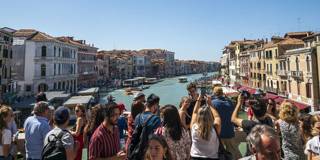In Venice, the high demand for tourist-related services that guarantee large markups has crowded out the supply of services for residents. In the absence of a long-term revitalization strategy, the historic city will remain on the path to becoming a cultural mausoleum.
MILAN – Countries with great wealth or natural abundance often fall victim to their own blessings. Economists have long known that resource-rich countries can get stuck in cycles of slow economic growth, intense environmental degradation, and weak democratic institutions. But places endowed with a unique artistic and architectural heritage also can suffer from this “resource curse.” Breathtaking monuments from a storied past can generate economic rents and sectoral distortions not unlike those created by large reserves of fossil fuels and precious minerals.

MILAN – Countries with great wealth or natural abundance often fall victim to their own blessings. Economists have long known that resource-rich countries can get stuck in cycles of slow economic growth, intense environmental degradation, and weak democratic institutions. But places endowed with a unique artistic and architectural heritage also can suffer from this “resource curse.” Breathtaking monuments from a storied past can generate economic rents and sectoral distortions not unlike those created by large reserves of fossil fuels and precious minerals.